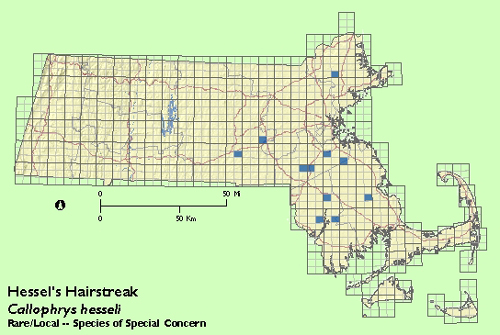Find a Butterfly
Hessel's Hairstreak
Callophrys hesseli
Named
Rawson & Ziegler, 1950
Identification
Wingspan: 7/8-1". Hessel‘s Hairstreak may only be confused with its sibling species, the Juniper Hairstreak. Both species are largely bright green on the underside, with some reddish brown spotting on the underside of the hindwing. Best distinguished from Juniper Hairstreak by subtle details of the underwing pattern. In Juniper the submarginal line of white dashes on the underside of the forewing form a smooth curve; in Hessel‘s this line has an inward curving "jog" near the top. The hindwing spotting of Hessel‘s tends to be bolder and more disjunct than that of Juniper in which the spots are more connected creating a more linear effect. In Juniper the lowest of the white crescents on the hindwing is shallow and is concave inward; that of Hessel‘s is deeper like a backward "c", i.e. concave outward. Hessel‘s below tends to be a brighter, darker shade of green; Juniper more olive. Doubtless the easiest clue to identification is habitat, described below.
Distribution
Southernmost Maine to northern Florida, primarily in the coastal plain. In New England, occurs from southern Maine southward, in or near Atlantic White Cedar.
Status in Massachusetts
The first recorded capture in the state, a female caught in Milton in 1941, was not attributed to this species until 1950, the year the species was named. (Sidney Hessel, an amateur lepidopterist from Connecticut, discovered the distinctions between Hessel‘s and Juniper Hairstreaks, and the species is named in honor of him). The Milton locality remained the sole known Massachusetts site until W. D. Winter discovered colonies in Westwood and Dover in the early 1980s and R. Pease found the species at Wilbraham in 1982. During the Atlas years, ten additional sites were located, a significant increase in the species‘ known range in Massachusetts. The Hessel‘s Hairstreak is intimately associated with Atlantic White Cedar (Chamaecyparis thyroides), the species‘ only larval food plant, and all state records of the species come from within or in close proximity to stands of Atlantic White Cedar. This tree grows in stands in bogs and is well distributed in eastern Massachusetts, with a few localities in the southern Connecticut Valley. An informal survey during the last week of May, 1988 turned up six Hessel‘s Hairstreak populations in as many cedar swamps. This suggests that the species may be commoner than previously thought, although lack of significant field work still clouds the species‘ exact status. Maximum: 8 10 on 28 May 1988, Raynham (Bristol Co.). Listed as a species of Special Concern under the Massachusetts Endangered Species Act.

Flight Period in Massachusetts
In New England, at the northern edge of its range, the Hessel‘s Hairstreak is said to have a single spring flight. Extreme dates: 16 May 1991, Sharon (Norfolk Co.), B. Cassie and 11 June 1988, North Andover (Essex Co.), S. Goldstein. Additional field work is needed to establish the absence or presence of a partial second brood.
Larval Food Plants
Atlantic White Cedar is the sole natural host. Red Cedar, (Juniperus virginiana) the larval food source of the Juniper Hairstreak, has been substituted in laboratory work and has been eaten under those circumstances.
Adult Food sources
Highbush Blueberry, shadbushes, Sweet Pepperbush, Buttonbush, and dogbanes are among flowering plants listed by Opler and Krizek (1984). In addition, Atlas workers have recorded this species nectaring at Choke Cherry, Yarrow, laurel, and Leatherleaf.
Habitat
Usually found in close proximity to stands of Atlantic White Cedar, the Hessel‘s Hairstreak occasionally travels up to half a mile in search of nectaring plants.
Life Cycle
Same as Juniper Hairstreak for egg, oviposition, larva, and pupation. Adult males may be found perched at 3 30‘ on the host plant. Hessel‘s Hairstreaks are difficult to spot, owing to their small size and green coloration, and are often first noticed when fluttering out from a tree which has been jarred. Mating apparently occurs in the vicinity of the host plant. The species overwinters as a pupa.
Notes
As goes the Atlantic White Cedar, so goes the Hessel‘s Hairstreak, and although New England has decent stands of Atlantic White Cedar at the northern extremity of this tree‘s range, there are great pressures on cedar swamps and more are being cut, drained, or poisoned with each passing year. The future of this butterfly lies in conservation of its unique habitat.
Account Author
Brian Cassie



